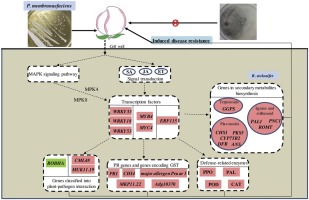当前位置:
X-MOL 学术
›
Postharvest Biol. Technol.
›
论文详情
Our official English website, www.x-mol.net, welcomes your
feedback! (Note: you will need to create a separate account there.)
Postharvest biological control of Rhizopus rot and the mechanisms involved in induced disease resistance of peaches by Pichia membranefaciens
Postharvest Biology and Technology ( IF 6.4 ) Pub Date : 2020-05-01 , DOI: 10.1016/j.postharvbio.2020.111146 Xiaoyun Zhang , Feng Wu , Ning Gu , Xueli Yan , Kaili Wang , Solairaj Dhanasekaran , Xiangyu Gu , Lina Zhao , Hongyin Zhang
Postharvest Biology and Technology ( IF 6.4 ) Pub Date : 2020-05-01 , DOI: 10.1016/j.postharvbio.2020.111146 Xiaoyun Zhang , Feng Wu , Ning Gu , Xueli Yan , Kaili Wang , Solairaj Dhanasekaran , Xiangyu Gu , Lina Zhao , Hongyin Zhang

|
Abstract Biological control of postharvest diseases of fruit by antagonistic yeast has been considered to be an effective and promising strategy to reduce the postharvest loss of fruits. In this study, the biocontrol efficacy of Pichia membranefaciens against Rhizopus rot of peaches was investigated. Also, the study was aimed to explore the mechanisms involved in the induced disease resistance of peaches by investigating the activities of defense-related enzymes and transcriptome analysis. The results indicated that P. membranefaciens had significant biocontrol efficacy against Rhizopus rot of peaches. The activities of defense-related enzymes including PPO, POD, PAL and CAT were potentially induced by this yeast. The transcriptome analysis revealed that MAPK cascade signaling pathway and signal transduction pathways of ethylene (ET), jasmonate (JA) and salicylic acid (SA) were triggered in peaches by P. membranefaciens to regulate the transcription factors (TFs). Then, these TFs further mediated the expression of downstream defense-related genes including PR genes (PR1, CHI4 and major allergen Pru ar 1) and glutathione S-transferase (GST) genes (MKP11.22 and Atlg10370), the genes classified into plant-pathogen interaction pathways (CML48, MUK11.19 and ROBHA) and the genes involved in the synthesis of secondary metabolites (GGPS, PKS5, CHS1, CYP75B2, DFR, LDOX, PAL, PNC1 and ROMT) to enhance the disease resistance potential of peaches. Besides, the accumulation of some antifungal compounds including flavonoids and lignin was stimulated to enhance the antifungal ability of peaches. Consequently, the present study contributes to understand the mechanisms behind the induced disease resistance of peaches by antagonistic yeast, and would provide new disease control strategy by improving the defense responses of fruit against pathogens.
中文翻译:

根霉病的采后生物防治及膜壁毕赤酵母诱导桃子抗病性的机制
摘要 拮抗酵母对果实采后病害的生物防治被认为是减少果实采后损失的有效且有前景的策略。本研究考察了膜毕赤酵母对桃根腐病的生防效果。此外,该研究旨在通过研究防御相关酶的活性和转录组分析来探索桃子诱导抗病性的机制。结果表明,P.filmfaciens对桃根霉病具有显着的生防效果。这种酵母可能会诱导防御相关酶(包括 PPO、POD、PAL 和 CAT)的活性。转录组分析揭示了MAPK级联信号通路和乙烯(ET)信号转导通路,茉莉酸 (JA) 和水杨酸 (SA) 在桃子中由 P.filmfaciens 触发以调节转录因子 (TF)。然后,这些 TF 进一步介导下游防御相关基因的表达,包括 PR 基因(PR1、CHI4 和主要过敏原 Pru ar 1)和谷胱甘肽 S-转移酶 (GST) 基因(MKP11.22 和 Atlg10370),这些基因属于植物-病原体相互作用途径(CML48、MUK11.19 和 ROBHA)和参与次级代谢产物合成的基因(GGPS、PKS5、CHS1、CYP75B2、DFR、LDOX、PAL、PNC1 和 ROMT)以增强桃子的抗病潜力. 此外,刺激了一些抗真菌化合物包括黄酮类和木质素的积累,以增强桃子的抗真菌能力。最后,
更新日期:2020-05-01
中文翻译:

根霉病的采后生物防治及膜壁毕赤酵母诱导桃子抗病性的机制
摘要 拮抗酵母对果实采后病害的生物防治被认为是减少果实采后损失的有效且有前景的策略。本研究考察了膜毕赤酵母对桃根腐病的生防效果。此外,该研究旨在通过研究防御相关酶的活性和转录组分析来探索桃子诱导抗病性的机制。结果表明,P.filmfaciens对桃根霉病具有显着的生防效果。这种酵母可能会诱导防御相关酶(包括 PPO、POD、PAL 和 CAT)的活性。转录组分析揭示了MAPK级联信号通路和乙烯(ET)信号转导通路,茉莉酸 (JA) 和水杨酸 (SA) 在桃子中由 P.filmfaciens 触发以调节转录因子 (TF)。然后,这些 TF 进一步介导下游防御相关基因的表达,包括 PR 基因(PR1、CHI4 和主要过敏原 Pru ar 1)和谷胱甘肽 S-转移酶 (GST) 基因(MKP11.22 和 Atlg10370),这些基因属于植物-病原体相互作用途径(CML48、MUK11.19 和 ROBHA)和参与次级代谢产物合成的基因(GGPS、PKS5、CHS1、CYP75B2、DFR、LDOX、PAL、PNC1 和 ROMT)以增强桃子的抗病潜力. 此外,刺激了一些抗真菌化合物包括黄酮类和木质素的积累,以增强桃子的抗真菌能力。最后,











































 京公网安备 11010802027423号
京公网安备 11010802027423号